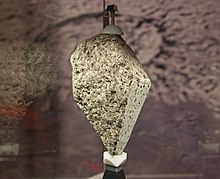Late Imbrian
Appearance
It has been suggested that this article be merged with Early Imbrian. (Discuss) Proposed since July 2015. |

In the Lunar geologic timescale, the Late Imbrian epoch occurred between 3800 million years ago to about 3200 million years ago. It was the epoch during which the mantle below the lunar basins partially melted and filled them with basalt. The melting is thought to have occurred because the impacts of the Early Imbrian thinned the overlying rock - either causing the mantle to rise because of the reduced pressure on it, bringing molten material closer to the surface; or the top melting as heat flowed upwards through the mantle because of reduced overlying thermal insulation. The majority of lunar samples returned to earth for study come from this epoch.
The Earth equivalent consists of half of the Archean eon.

Millions of years before present
